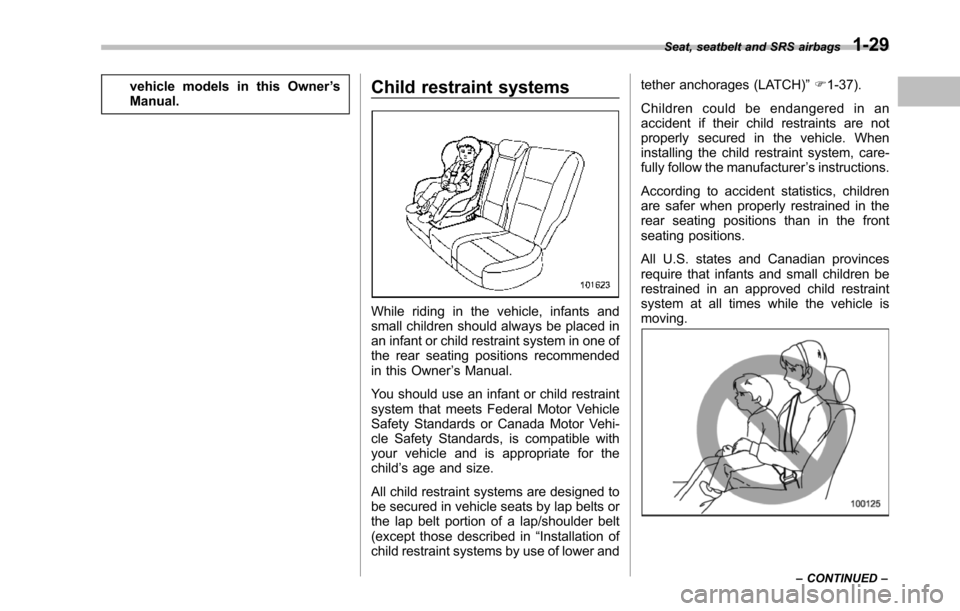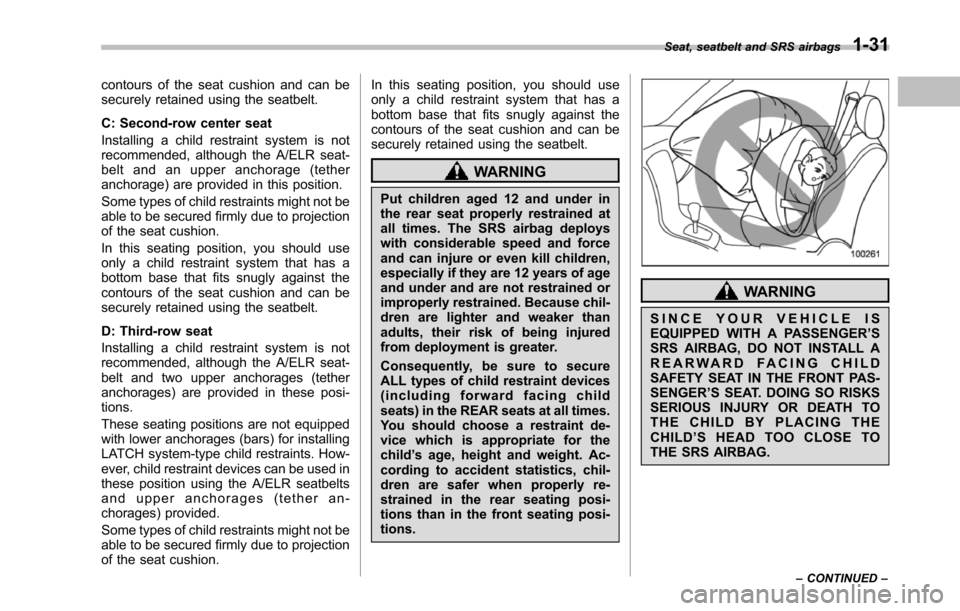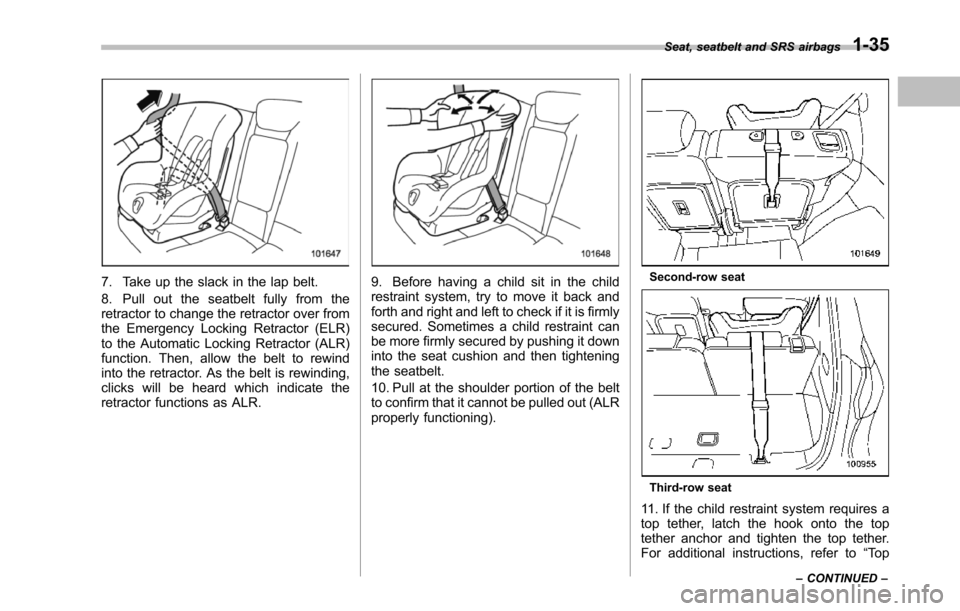2014 SUBARU TRIBECA child seat
[x] Cancel search: child seatPage 49 of 426

1-18Seat, seatbelt and SRS airbags
the face or neck, adjust the shoulder beltanchor height (window-side seating posi-tions only) and then if necessary move thechild closer to the belt buckle to helpprovide a good shoulder belt fit. Care mustbe taken to securely place the lap belt aslow as possible on the hips and not on thechild’s waist. If the shoulder portion of thebelt cannot be properly positioned, a childrestraint system should be used. Neverplacethe shoulder belt under the child’sarm or behind the child’s back.
!Expectant mothers
Expectant mothers also need to use theseatbelts. They should consult their doctorfor specific recommendations. The lap beltshouldbe worn securely and as low aspossible over the hips, not over the waist.
&Emergency Locking Retrac-
tor (ELR)
The driver’s seatbelt has an EmergencyLocking Retractor (ELR).
The emergency locking retractor allowsnormal body movement but the retractorlocks automatically during a sudden stop,impact or if you pull the belt very quicklyout of the retractor.
&Automatic/Emergency Lock-
ing Retractor (A/ELR)
Each passenger’s seatbelt has an Auto-matic/Emergency Locking Retractor (A/ELR). The Automatic/Emergency LockingRetractor normally functions as an Emer-gency Locking Retractor (ELR). The A/ELR has an additional locking mode,“Automatic Locking Retractor (ALR)mode”, intended to secure a child restraintsystem.
The ALR mode functions as follows.
When the seatbelt is once drawn outcompletely and is then retracted evenslightly, the retractor locks the seatbelt inthat position and the seatbelt cannot beextended. As the belt is rewinding, clickswill be heard which indicate the retractorfunctions as an ALR. When the seatbelt isretracted fully, the ALR mode is canceledand the ELR mode is restored.
When securing a child restraint system onthe rear passenger’s seats by using aseatbelt, the seatbelt must be changedover to the Automatic Locking Retractor(ALR) mode. For instructions on how toinstall the child restraint system using aseatbelt, refer to“Installing child restraintsystems with A/ELR seatbelt”F1-32.
When the child restraint system is re-moved, make sure that the retractor isrestored to the Emergency Locking Re-tractor (ELR) mode by allowing the seat-belt to retract fully.
&Seatbelt warning light
and chime
Refer to“Seatbelt warning light andchime”F3-10.
&Fastening the seatbelt
WARNING
.Never use a belt that is twisted orreversed. In an accident, this canincrease therisk or severity ofinjury.
.Keep the lap belt as low aspossible on your hips. In a colli-sion, this spreads the force of thelap belt over stronger hip bones
Page 60 of 426

vehicle models in this Owner’sManual.Child restraint systems
Whileriding in the vehicle, infants andsmall children should always be placed inan infant or child restraint system in one ofthe rear seating positions recommendedin this Owner’s Manual.
You should use an infant or child restraintsystem that meets Federal Motor VehicleSafetyStandards or Canada Motor Vehi-cle Safety Standards, is compatible withyour vehicle and is appropriate for thechild’s age and size.
Allchild restraint systems are designed tobe secured in vehicle seats by lap belts orthe lap belt portion of a lap/shoulder belt(except those described in“Installation ofchild restraint systems by use of lower and
tether anchorages (LATCH)”F1-37).
Children could be endangered in anaccident if their child restraints are notproperly secured in the vehicle. Wheninstalling the child restraint system, care-fully follow the manufacturer’s instructions.
According to accident statistics, childrenare safer when properly restrained in therear seating positions than in the frontseating positions.
All U.S. states and Canadian provincesrequire that infants and small children berestrained in an approved child restraintsystem at all times while the vehicle ismoving.
Seat, seatbelt and SRS airbags1-29
–CONTINUED–
Page 61 of 426

1-30Seat, seatbelt and SRS airbags
WARNING
Never let a passenger hold a childon his or her lap while the vehicle ismoving. The passenger cannot pro-tect the child from injury in a colli-sion, because the child will becaught between the passenger andobjects inside the vehicle. Addition-ally, holding a child in your lap orarms in the front seat exposes thatchild to another serious danger.Since the SRSairbag deploys withconsiderable speed and force, thechild could be injured or even killed.
WARNING
Children should be properly re-strained at all times. Never allow achild to stand up, or to kneel on anyseat. Unrestrained children will bethrown forward during sudden stopor in an accident and can be injuredseriously.
Additionally, children standing up orkneeling on or in front of the frontseat are exposed another seriousdanger. Since the SRS airbag de-ployswith considerable speed andforce, the child could be injured oreven killed.
&Where to place a child re-
straint system
The following are SUBARU’s recommen-dations on where to place a child restraintsystem in your vehicle.
A: Front passenger’s seat
You should not install a child restraintsystem (including a booster seat) due tothe hazard to children posed by thepassenger’s airbag.
B: Second-row outboard seats
Recommended positions for all types ofchild restraint systems.
In these positions, Automatic/EmergencyLocking Retractor (A/ELR) seatbelts andlower anchorages (bars) are provided forinstalling a child restraint system.
Some types of child restraints might not beable to be secured firmly due to projectionof the seat cushion.
In this seating position, you should useonly a child restraint system that has abottom base that fits snugly against the
Page 62 of 426

contours of the seat cushion and can besecurely retained using the seatbelt.
C: Second-row center seat
Installing a child restraint system is notrecommended, although the A/ELR seat-belt and an upper anchorage (tetheranchorage) are provided in this position.
Some types of child restraints might not beable to be secured firmly due to projectionof the seat cushion.
In this seating position, you should useonly a child restraint system that has abottom base that fits snugly against thecontours of the seat cushion and can besecurelyretained using the seatbelt.
D: Third-row seat
Installing a child restraint system is notrecommended, although the A/ELR seat-belt and two upper anchorages (tetheranchorages)are provided in these posi-tions.
These seating positions are not equippedwith lower anchorages (bars) for installingLATCH system-type child restraints. How-ever, child restraint devices can be used inthese position using the A/ELR seatbeltsand upper anchorages (tether an-chorages) provided.
Some typesof child restraints might not beable to be secured firmly due to projectionof the seat cushion.
In this seating position, you should useonly a child restraint system that has abottom base that fits snugly against thecontours of the seat cushion and can besecurely retained using the seatbelt.
WARNING
Put children aged 12 and under inthe rear seat properly restrained atalltimes. The SRS airbag deployswith considerable speed and forceand can injure or even kill children,especially if they are 12 years of ageand under and are not restrained orimproperly restrained. Because chil-dren are lighter and weaker thanadults, their risk of being injuredfrom deployment is greater.
Consequently, be sure to secureALL types of child restraint devices(including forward facing childseats) in the REAR seats at all times.You should choose a restraint de-vice which is appropriate for thechild’s age, height and weight. Ac-cording to accident statistics, chil-dren are safer when properly re-strained in the rear seating posi-tions than in the front seating posi-tions.
WARNING
SINCE YOUR VEHICLE ISEQUIPPED WITH A PASSENGER’SSRS AIRBAG, DO NOT INSTALL AREARWARD FACING CHILDSAFETY SEAT IN THE FRONT PAS-SENGER’S SEAT. DOING SO RISKSSERIOUS INJURY OR DEATH TOTHE CHILD BY PLACING THECHILD’SHEADTOOCLOSETOTHE SRS AIRBAG.
Seat, seatbelt and SRS airbags1-31
–CONTINUED–
Page 63 of 426

1-32Seat, seatbelt and SRS airbags
&Choosing a child restraint
system
Choose a child restraint system that isappropriate for the child’s age and size(weight and height) in order to provide thechild with proper protection. The childrestraint system should meet all applic-able requirements of Federal Motor Vehi-cle Safety Standards for United States orCanada Motor Vehicle Safety Standardsfor Canada. It can be identified by lookingfor the label on the child restraint systemor the manufacturer’s statement of com-pliance in the document attached to thesystem. Also it is important for you tomake sure thatthe child restraint systemis compatible with the vehicle in which itwill be used.
&Installing child restraint sys-
tems with A/ELR seatbelt
WARNING
.Child restraint systems and seat-belts can become hot in a vehiclethat has been closed up in sunnyweather; they could burn a smallchild. Check the child restraintsystem before you place a childin it.
.Do not leave an unsecured childrestraint system in your vehicle.Unsecured child restraint sys-tems can be thrown around in-side of the vehicle in a suddenstop, turn or accident; they canstrikeand injure vehicle occu-pants as well as result in seriousinjuries or death to the child.
CAUTION
When you install a child restraintsystem, follow the manufacturer’sinstructions supplied with it. Afterinstalling the child restraint system,check to ensure that it is heldsecurely in position. If it is not heldtight and secure, the danger of your
child suffering personal injury in theevent of an accident may be in-creased.
!Installing a rearward facing childrestraint
1. Slide the seat or seat pair to itsrearmost position.
2. Adjust the seatback to the uprightposition.
3. Place the child restraint system in therear seating position.
4. Run the lap and shoulder belt throughor around the child restraint systemfollowing the instructions provided by itsmanufacturer.
5. Insert the tongue plate into the buckleuntil you hear a click.
Page 64 of 426

6. Take up the slack in the lap belt.
7. Pull out the seatbelt fully from theretractor to change the retractor over fromthe Emergency Locking Retractor (ELR)to the Automatic Locking Retractor (ALR)mode. Then, allow the belt to rewind intothe retractor. As the belt is rewinding,clicks will be heard which indicate theretractor functions as ALR.
8. Push and pull the child restraintsystem forward and from side to side tocheck if it is firmly secured.
Sometimes a child restraint can be morefirmlysecured by pushing it down into theseat cushion and then tightening theseatbelt.
9. Pull at the shoulder portion of the beltto confirm that it cannot be pulled out (ALRproperly functioning).
10. To remove the child restraint system,press the release button on the seatbeltbuckle and allow the belt to retractcompletely. The belt will return to theELR mode.
WARNING
NEVER INSTALL A REARWARD FA-CING CHILD SEAT IN THE FRONTPA S S E N G E R’SSEAT.DOINGSORISKS SERIOUS INJURY OR DEATHTO THE CHILD BY PLACING THECHILD’S HEAD TOO CLOSE TO THESRS AIRBAG.
Seat, seatbelt and SRS airbags1-33
–CONTINUED–
Page 65 of 426

1-34Seat, seatbelt and SRS airbags
NOTE
When the child restraint system is nolonger in use, remove it and restore theELR mode of the retractor. That modeis restored by retracting the seatbeltfully.
!Installingforward facing child re-straint
Second-row outboard seat1) Head restraint2) Release button
Second-row center seat1) Head restraint2) Release button
Third-row seat1) Head restraint2) Lowering strap
1. When installing on thesecond-rowoutboard seat, remove the head restraint.When installing on thesecond-row cen-ter seat, raise the head restraint. Wheninstalling on thethird-row seat, lower thehead restraint.
2. Slide the seat or seat pair to itsrearmost position.
3. Adjust the seatback to the uprightposition.
4. Place the child restraint system in theseatingposition.
5. Run the lap and shoulder belt throughor around the child restraint systemfollowing the instructions provided by itsmanufacturer.
6. Insert the tongue plate into the buckleuntil you hear a click.
Page 66 of 426

7. Take up the slack in the lap belt.
8. Pull out the seatbelt fully from theretractor to change the retractor over fromthe Emergency Locking Retractor (ELR)to the Automatic Locking Retractor (ALR)function. Then, allow the belt to rewindinto the retractor. As the belt is rewinding,clicks will be heard which indicate theretractor functions as ALR.
9. Before having a child sit in the childrestraint system, try to move it back andforth and right and left to check if it is firmlysecured. Sometimes a child restraint canbe more firmly secured by pushing it downinto the seat cushion and then tighteningtheseatbelt.
10. Pull at the shoulder portion of the beltto confirm that it cannot be pulled out (ALRproperly functioning).
Second-row seat
Third-row seat
11. If the child restraint system requires atop tether, latch the hook onto the toptether anchor and tighten the top tether.For additional instructions, refer to“To p
Seat, seatbelt and SRS airbags1-35
–CONTINUED–